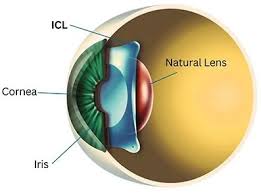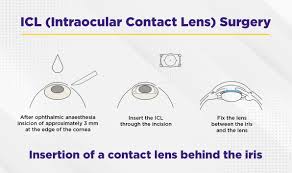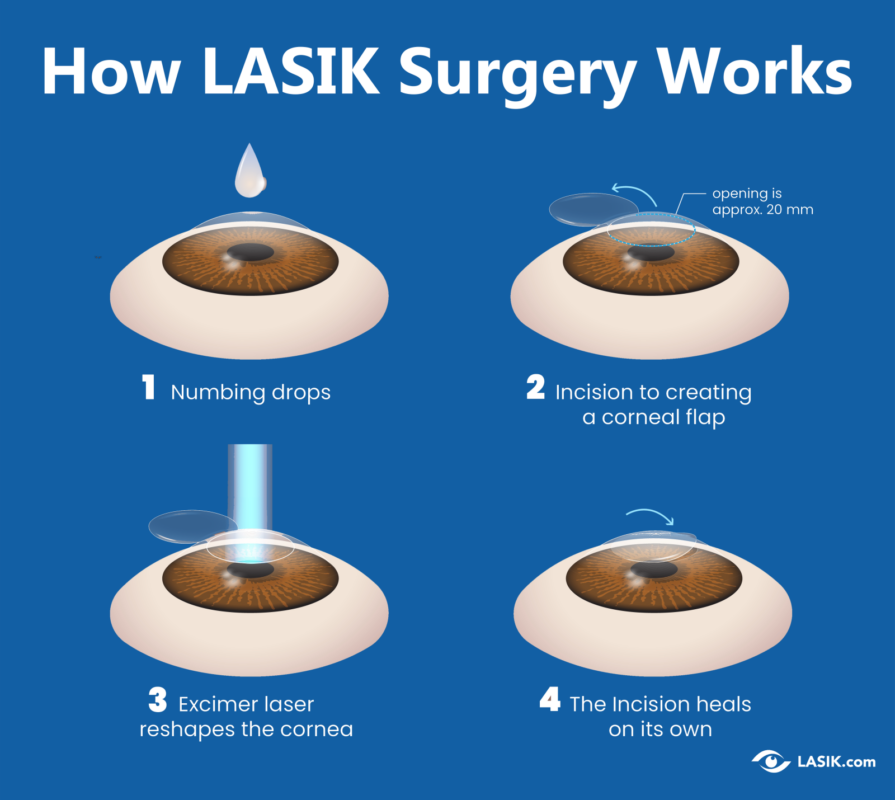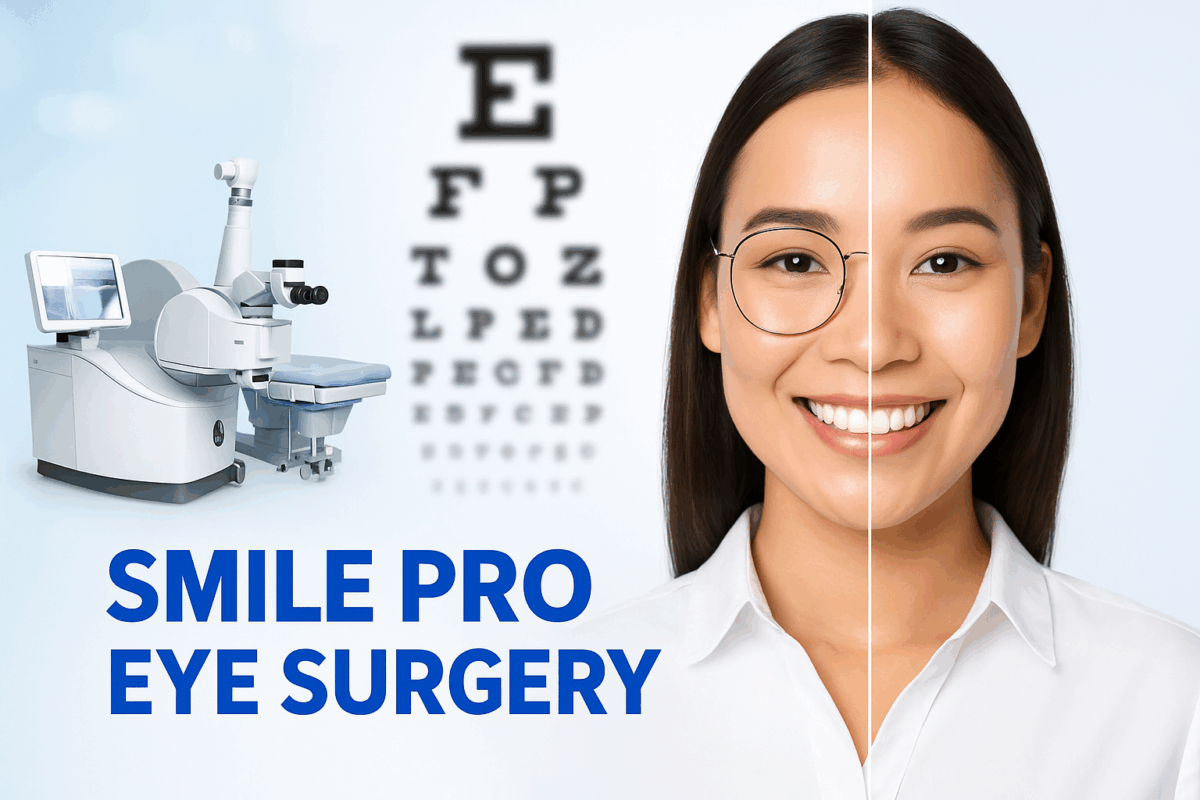Introduction to ICLs
When it comes to correcting vision, several options are available, including glasses, contact lenses, and refractive surgeries like LASIK. However, Implantable Collamer Lenses (ICLs) have emerged as a cutting-edge alternative for those seeking permanent vision correction. Offering a solution that combines the best of both worlds—long-term vision correction and reversibility—ICLs have gained popularity among people who may not be suitable candidates for traditional refractive surgeries. This comprehensive guide will provide you with all the essential information about ICLs, from how they work to the benefits, risks, costs, and what to expect during the procedure.
What Are ICLs?
Surgeons implant Implantable Collamer Lenses (ICLs) inside the eye to correct refractive errors, such as myopia (nearsightedness), hyperopia (farsightedness), and astigmatism. Made from Collamer, a biocompatible material, the lens works in harmony with the eye’s natural structure. Unlike traditional contact lenses, which sit on the surface, ICLs are placed inside the eye, typically between the cornea and the natural lens.
ICLs are a great alternative for individuals who want a permanent solution to their vision problems but are not candidates for LASIK or PRK (Photorefractive Keratectomy) due to factors such as thin corneas, high prescription strength, or dry eyes.

How Do They Work?
ICLs work by altering the way light enters the eye to achieve optimal focus on the retina, similar to LASIK. However, instead of reshaping the cornea, ICLs correct refractive errors by adding a lens inside the eye to adjust the light path. This allows the eye to focus more accurately, resulting in improved vision.
ICL surgery is minimally invasive, and the lenses are designed to be both safe and effective. Since surgeons place ICLs inside the eye, patients no longer need external correction, such as glasses or contact lenses, which can be inconvenient for some people. Additionally, unlike laser surgeries that alter the shape of the cornea, doctors can remove or replace ICLs if necessary, making the procedure reversible.
Why Consider ICLs?
Advantages Over Glasses and Contacts
ICLs provide a permanent solution to vision correction, offering the convenience of no longer needing to rely on glasses or contact lenses. Many people find contact lenses to be uncomfortable or inconvenient, while glasses can be cumbersome, especially during physical activities. ICLs provide a hassle-free, long-lasting solution, ensuring clearer vision without the constant need for corrective eyewear.
ICLs vs. LASIK
While LASIK has been a popular choice for refractive surgery, ICLs offer some distinct advantages, particularly for patients who may not be good candidates for LASIK. LASIK works by reshaping the cornea, but for individuals with thin corneas, high refractive errors, or dry eyes, LASIK may not be ideal. On the other hand, ICLs can correct a wider range of vision issues and are suitable for people who are not candidates for LASIK.
ICLs are reversible—unlike LASIK, which permanently changes the shape of the cornea, doctors can remove or replace the lens if necessary. ICLs also offer a safer option for individuals with dry eyes or thin corneas, conditions that LASIK surgery can aggravate.
Who Is a Candidate for ICL Surgery?
Ideal Candidates
The ideal candidate for ICL surgery is someone who has a refractive error that glasses or contact lenses cannot fully correct. Candidates typically include those with:
- Moderate to high levels of myopia (nearsightedness) or hyperopia (farsightedness)
- Astigmatism (which can be corrected with Toric ICLs)
- Healthy eyes with no significant eye conditions like cataracts or corneal disease
- Age between 21 and 45 years (though it may vary depending on individual factors)
- Good overall health and a stable prescription for at least a year
Who Should Avoid ICLs?
Although ICLs offer an effective solution for many people, not everyone is a suitable candidate. You may not be eligible for ICL surgery if you have:
- Uncontrolled eye conditions, such as glaucoma or cataracts
- Severe dry eye syndrome, which may be worsened by implanting a lens
- Pregnancy or breastfeeding, as refractive errors can fluctuate during these times
- Corneal scarring or other conditions affecting the cornea
- Thin corneas (though this is a more common issue for LASIK candidates rather than ICL candidates)
Consulting with an experienced ophthalmologist is critical to determining if ICL surgery is the right choice for you.
Types of ICLs
Doctors design two main types of ICLs to correct different refractive errors:
Toric ICLs for Astigmatism
Doctors design Toric ICLs specifically for individuals with astigmatism, a condition where an irregularly shaped cornea causes blurry or distorted vision. These lenses have a special design that allows them to correct the curvature of the cornea, providing clearer and sharper vision for astigmatism sufferers.
Standard ICLs
Doctors use standard ICLs to treat refractive errors such as myopia (nearsightedness) and hyperopia (farsightedness). These lenses help focus light entering the eye in a way that improves the clarity of vision, offering a permanent alternative to glasses or contacts.
The ICL’s Implantation Procedure
Pre-Surgery Preparations
Before undergoing ICL surgery, you will need to attend a comprehensive consultation with your ophthalmologist. During this visit, your doctor will evaluate your eye health and take measurements to determine the correct size and power of the implantable lenses. You will also need to stop wearing contact lenses for at least two weeks before your consultation to ensure accurate measurements of your cornea.
Step-by-Step Surgery Process for ICLs
ICL surgery is a minimally invasive procedure that is typically performed on an outpatient basis. The process usually involves the following steps:
- Anesthesia: The doctor administers local anesthesia to numb the eye, ensuring the patient remains comfortable and pain-free during the procedure while staying awake and aware.
- Incision: A small incision is made in the cornea to allow access to the inner part of the eye.
- Lens Insertion: The ICL is inserted through the incision and carefully positioned in the eye, between the iris and the natural lens.
- Closure: The incision is self-healing and does not require sutures. In most cases, it will seal on its own after the procedure.
The surgery typically takes about 15-30 minutes per eye. Most patients experience minimal discomfort during the surgery, and they generally tolerate the procedure well.

Post-Surgery Care
After surgery, your doctor will give you specific post-operative care instructions, including the use of antibiotic and anti-inflammatory eye drops to prevent infection and reduce inflammation. You may also need to wear an eye shield during sleep for the first few nights to prevent rubbing your eyes.
Follow-Up Appointments
Follow-up visits are essential to monitor the healing process and ensure that the ICL is positioned correctly. Typically, follow-up visits will occur the day after surgery, one week later, and then at regular intervals during the healing process.
Benefits of ICL Surgery
Permanent Yet Reversible Solution
ICLs provide permanent vision correction, offering a clear, glasses-free lifestyle. However, unlike LASIK, the lenses are reversible. Doctors can remove or replace the lenses with a different prescription if needed, allowing for a more flexible approach to vision correction.
UV Protection
ICLs provide UV protection, helping to shield the eye from the harmful effects of ultraviolet light. This feature can help protect the eyes from conditions like cataracts and macular degeneration in the long term.
Enhanced Night Vision
Many patients experience enhanced night vision after ICL surgery, particularly those who struggled with glare and halos around lights while wearing glasses or contacts. The design of the ICLs allows them to fit perfectly within the eye, improving light refraction and reducing nighttime visual disturbances.
Risks and Complications for ICLs
Potential Side Effects ICLs urgery
As with any surgical procedure, there are potential risks and side effects associated with ICL surgery, though they are relatively rare. These can include:
- Infection
- Inflammation
- Elevated intraocular pressure (IOP)
- Cataract formation (in rare cases)
- Night vision issues (rare)
- Lens dislocation or shift
How to Minimize Risks ICLs surgery
To minimize risks, it’s essential to choose a highly qualified ophthalmologist with experience performing ICL surgery. Following all pre- and post-surgery care instructions and attending all follow-up appointments can also help ensure a successful outcome.
Cost of ICL Surgery
Factors Affecting Price for ICLs suegery
The cost of ICL surgery can vary depending on factors such as the surgeon’s experience, the geographic location of the clinic, the type of ICL used, and any additional costs associated with the procedure (such as pre-surgery evaluations and post-op care).
Cost Comparison with LASIK and PRK
ICL surgery typically comes at a higher cost compared to LASIK or PRK due to the advanced technology and specialized procedure involved. On average, the cost of ICL surgery can range from $3,000 to $5,000 per eye, compared to LASIK, which typically costs between $2,000 and $3,000 per eye. However, many patients find the added benefits of ICLs, including reversibility and suitability for a wider range of candidates, justify the higher cost.
Recovery and Aftercare for ICLs surgery
Healing Timeline
Recovery from ICL surgery is typically quick, with most patients noticing improved vision within a few days. Full recovery may take several weeks, during which time you may experience mild discomfort, dryness, or blurry vision.
Post-Op Restrictions and Guidelines
Patients are generally advised to avoid strenuous activities, swimming, and eye makeup for a few weeks after surgery. You should also avoid rubbing your eyes and protect your eyes from direct sunlight.
ICL Success Rate and Patient Satisfaction
Statistics and Case Studies for ICLs surgery
ICL surgery boasts a high success rate, with studies showing that over 95% of patients achieve 20/40 vision or better following the procedure. Many patients report high levels of satisfaction, especially those with higher prescriptions who were not candidates for LASIK.
Real-Life Testimonials
Real-life testimonials from patients who have undergone ICL surgery are overwhelmingly positive, with many noting a significant improvement in their quality of life. Testimonials often highlight the convenience of not needing glasses or contact lenses and the ease of the recovery process.
Myths and Misconceptions About ICLs
Common Myths Debunked for ICLs
Many myths surround ICL surgery, such as the belief that it is extremely painful or that it always leads to complications. In reality, the surgery is minimally invasive, and most patients report little discomfort during or after the procedure.
Scientific Facts for ICLs
ICL surgery is backed by decades of scientific research and clinical success, demonstrating its safety and efficacy for treating refractive errors.
How to Choose the Right Eye Surgeon for ICLs
What to Look for in a Specialist
When choosing an ophthalmologist for ICL surgery, look for someone with specialized training in refractive surgery and experience performing ICL implants. You should also consider factors such as patient reviews, hospital affiliations, and overall reputation in the medical community.
Questions to Ask During Consultation
During your consultation, ask questions about the surgeon’s experience with ICLs, the types of ICLs they use, and the expected outcomes. Be sure to discuss any potential risks and ask for a breakdown of the procedure, cost, and recovery timeline.
Future of ICL Technology
Innovations and Upcoming Trends for ICLs
The future
of ICL technology looks promising, with ongoing advancements in lens materials, customization, and overall safety. Innovations such as advanced imaging techniques for precise lens measurements and new lens designs that treat a broader range of refractive errors are expected to make ICL surgery even more effective in the coming years.
Conclusion
Implantable Collamer Lenses (ICLs) offer a safe, effective, and customizable solution for individuals seeking permanent vision correction. With their numerous benefits, including reversibility, UV protection, and enhanced night vision, ICLs present an excellent alternative to traditional glasses, contacts, and even LASIK surgery. While there are potential risks involved, the success rate of ICL surgery is very high, and patient satisfaction remains overwhelmingly positive. If you’re considering ICL surgery, it’s important to consult with a qualified ophthalmologist to determine if this vision correction option is right for you.
Author Details:
Dr. Sushruth Appajigowda holds a prominent position as a Cornea, Cataract, Glaucoma, and LASIK Surgeon in Bangalore. He serves as the chief Cataract and Refractive surgeon at Vijaya Nethralaya Eye Hospital, Nagarbhavi Bangalore. Renowned as one of the finest LASIK surgeons nationwide, he brings with him over 12+ years of experience across multiple LASIK platforms, including ZEISS, ALCON, SCHWIND, AMO, and Bausch and Lomb. Having successfully conducted over 5000 LASIK procedures, Dr. Sushruth holds the title of a Certified Refractive Surgeon and a Fellow of the All India Collegium Of Ophthalmology. Furthermore, he stands as a distinguished speaker at various National and International Forums, using his expertise to guide you in selecting the most suitable procedure based on your health requirements.

http://vijayanethralaya.com/link-in-bio/
FAQs
Are ICLs safe?
Yes, ICLs are a safe and effective option for most people with refractive errors. As with any surgical procedure, there are risks, but the complications are rare, and the majority of patients experience excellent results.
Can the ICL be removed?
Yes, the ICL can be removed or replaced if needed. This is one of the key advantages of ICL surgery over LASIK.
Is ICL surgery permanent?
Yes, ICLs are a permanent solution for vision correction. However, because the lenses can be replaced or adjusted, they offer more flexibility than other types of refractive surgeries.











